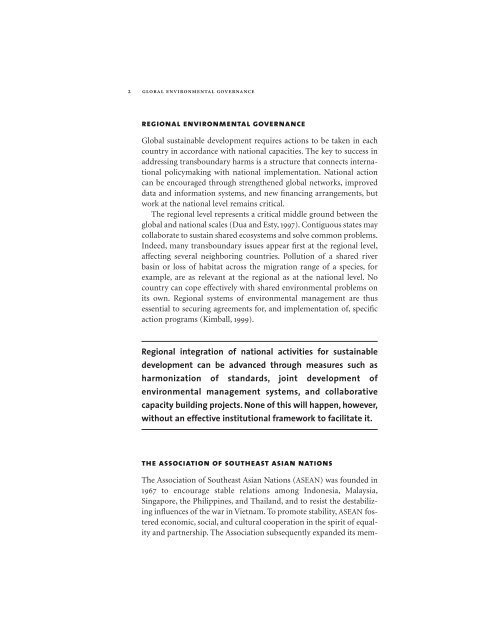Regional Environmental Governance: Examining ... - Yale University
Regional Environmental Governance: Examining ... - Yale University
Regional Environmental Governance: Examining ... - Yale University
You also want an ePaper? Increase the reach of your titles
YUMPU automatically turns print PDFs into web optimized ePapers that Google loves.
2<br />
GLOBAL ENVIRONMENTAL GOVERNANCE<br />
regional environmental governance<br />
Global sustainable development requires actions to be taken in each<br />
country in accordance with national capacities. The key to success in<br />
addressing transboundary harms is a structure that connects international<br />
policymaking with national implementation. National action<br />
can be encouraged through strengthened global networks, improved<br />
data and information systems, and new financing arrangements, but<br />
work at the national level remains critical.<br />
The regional level represents a critical middle ground between the<br />
global and national scales (Dua and Esty, 1997). Contiguous states may<br />
collaborate to sustain shared ecosystems and solve common problems.<br />
Indeed, many transboundary issues appear first at the regional level,<br />
affecting several neighboring countries. Pollution of a shared river<br />
basin or loss of habitat across the migration range of a species, for<br />
example, are as relevant at the regional as at the national level. No<br />
country can cope effectively with shared environmental problems on<br />
its own. <strong>Regional</strong> systems of environmental management are thus<br />
essential to securing agreements for, and implementation of, specific<br />
action programs (Kimball, 1999).<br />
<strong>Regional</strong> integration of national activities for sustainable<br />
development can be advanced through measures such as<br />
harmonization of standards, joint development of<br />
environmental management systems, and collaborative<br />
capacity building projects. None of this will happen, however,<br />
without an effective institutional framework to facilitate it.<br />
the association of southeast asian nations<br />
The Association of Southeast Asian Nations (ASEAN) was founded in<br />
1967 to encourage stable relations among Indonesia, Malaysia,<br />
Singapore, the Philippines, and Thailand, and to resist the destabilizing<br />
influences of the war in Vietnam. To promote stability, ASEAN fostered<br />
economic, social, and cultural cooperation in the spirit of equality<br />
and partnership. The Association subsequently expanded its mem-
















